#software test automation case study
Explore tagged Tumblr posts
Text
The genocide is also experimentation on living beings
Israel is currently testing new weapons in Gaza, some of which will soon be sold globally as "battle-tested," according to Antony Loewenstein, an author who has written a widely acclaimed book on the issue.
For years, the Israeli defense sector has used Palestine as a laboratory for new weapons and surveillance tech, he told Anadolu, adding that this is also the case in the current ongoing war on Gaza.
One of the main reasons why "many nations, democracies and dictatorships support Israeli occupation" of Palestine is because it allows them to buy these "battle-tested" weapons, asserted Loewenstein, author of The Palestine Laboratory: How Israel Exports the Technology of Occupation Around the World.
Another aspect of Israel's war on Gaza has been the use of artificial intelligence technology, he said.
According to Loewenstein, AI has been one of the key targeting tools used by the Israeli military in its deadly campaign of airstrikes, leading to mass killings of Palestinians-now over 28,500-and damage on an unprecedented scale.
The current war on Gaza is "inarguably one of the most consequential and bloody," he said.
He described Israel's use of AI against Palestinians as "automated murder," stressing that this model "will be studied and copied by other nation-states" and Tel Aviv will sell them these technologies as tried and tested weapons.
In the last 50 years, Israel has exported hi-tech surveillance tools to at least 130 countries around the world.
To maintain its illegal occupation of the West Bank and East Jerusalem, and blockade of the Gaza Strip, Israel has developed a range of tools and technologies that have made it the world's leading exporter of spyware and digital forensics tools.
But analysts say the intelligence failure during the Oct. 7, 2023 Hamas attacks casts doubts over Tel Avis's technological capabilities.
Israel's reliance on technology "is an illusion of safety, while imprisoning 2.3 million people under endless occupation," said Loewenstein, who is Jewish and holds Australian and German nationalities.
He described Israel's response in Gaza as "apocalyptic," stressing that the killings of Palestinian civilians, including children and women, is "on a scale of indiscriminate slaughter."
- 'BLOOD MONEY'
Loewenstein, who is also a journalist, said Israel has honed its weapons and technology expertise over decades as an occupying power, acting with increasing impunity in the Palestinian territories.
This led a small country like Israel to become one of the top 10 arms dealers in the world, he said, adding that Israeli arms sales in 2021 were "the highest on record, surging 55% over the previous two years to $11.3 billion."
In his book, Loewenstein explores thoroughly Israel's ties with autocracies and regimes engaged in mass displacement campaigns, and governments slinking their way into phones.
The Israeli NSO Group sold its well-known Pegasus software to numerous governments, a spyware tool for phones that gives access to the entire content, including conversations, text messages, emails and photos even when the device is switched off.
Israeli drones were first tested over Gaza, the besieged enclave that Loewenstein referred to as "the perfect laboratory for Israeli ingenuity in domination."
Surveillance technology developed in Israel has also been sold to the US in the form of watch towers now used on the border with Mexico.
The EU's border agency Frontex is known to have used Israeli drone technology to monitor refugees.
Loewenstein explains in his book that the EU has partnered with leading Israeli defense companies to use its drones, "and of course years of experience in Palestine is a key selling point."
"So again, one sees how there are so many examples of nations that are wanting to copy what Israel is doing in their own area in their own country on their own border," he said.
These technologies and "are sold by Israel as battle-tested," he said.
In other words, he contends that Palestinians essentially have become "guinea pigs," and despite some nations and the UN publicly criticizing the Israeli occupation, in reality "they're desperate for this technology for themselves for their own countries."
"And that's how in fact, the Palestine laboratory has been so successful for Israel for so long," he said.
In his exhaustive probe into Israel's dealings with arms sales around the world, he noted that the country has monetized the occupation of Palestine, by selling weapons, spyware tools and technologies to repressive regimes such as Rwanda during the genocide in 1994 and to Myanmar during its genocide against the Muslim Rohingya people in 2017.
"This to me is blood money. I mean, there's no other way to see that and again, as someone Jewish, who has spent many, many years reporting on this conflict, both within Israel and Palestine but also elsewhere, it's deeply shameful that Israel is making huge amounts of money from the misery of others," he said.
"This is not a legacy that I can be proud of."
- 'NO NATION ACTUALLY HOLDING ISRAEL TO ACCOUNT'
Profiting from misery is to some extent the nature of what capitalism has always been about, but Israel does this with a great deal of impunity, "because Israel does what it wants," said Loewenstein.
"There is no accountability, there is no transparency, there is no nation actually holding Israel to account," he added.
Israel's regime is shielded from any political backlash for years to come because nations are reliant on Israeli weapons and spyware, said the author.
Israel may not be the only player employing surveillance technology that leads to human rights violations, but it still plays a dominant role, which is why Loewenstein insists that it deserves singular attention.
Israel's foreign policy has always been "amoral and opportunistic," he said, calling on all nations to take a stand and hold Israel accountable, and acknowledge that the world is buying what Israel is selling.
#free palestine#animal rights#govegan#animalrights#free gaza#gaza strip#gaza genocide#palestine#veganism#animals
139 notes
·
View notes
Text
Enterprise Resource Management: Essential Software Testing Services

Enterprise Resource Management (ERM) software is the backbone of modern business operations, ensuring that all aspects of an organization work in harmony. To maximize the effectiveness of ERM software, thorough software testing services are essential. Here's how to approach it:
1. Importance of Software Testing in ERM
Software testing ensures that all ERM modules function correctly, avoiding disruptions in critical business processes.
2. Key Areas to Focus On
Functionality Testing: Validate that each module performs its intended function.
Performance Testing: Ensure the system can handle expected loads without lag.
Security Testing: Protect sensitive business data from potential breaches.
Integration Testing: Confirm that the ERM integrates smoothly with other enterprise systems.
3. Common Challenges
Software testing in ERM can be complex due to the interdependencies between different modules. It's crucial to adopt a comprehensive testing strategy that covers all bases.
4. Tools and Technologies
Utilize advanced testing tools like Selenium, JIRA, and LoadRunner to automate testing processes and improve accuracy.
5. Best Practices
Regularly update test cases to reflect changes in the software.
Involve end-users in the testing process to gather practical feedback.
Conduct both manual and automated tests for thorough coverage.
6. Case Studies
Successful ERM implementations highlight the role of rigorous testing in preventing system failures and enhancing overall performance.
7. Final Thoughts
Implementing robust software testing services in your ERM project ensures smooth operations and long-term success. Ensure that your ERM software not only meets current business needs but is also scalable for future growth.
2 notes
·
View notes
Text
Ideal Customer Persona: Marketing Director Mark
About Them
Name: Mark Thompson
Role: Marketing Director
Industry: SaaS (Software as a Service)
Company Size: Mid-sized (100-500 employees)
Demographics:
Age: 35-45 years old
Education: Bachelor's in Marketing or Business, often with an MBA
Location: Urban areas with a tech industry presence (e.g., San Francisco, New York, Austin)
Experience: 10+ years in marketing, 3-5 years in a leadership role
Professional Background:
Strong understanding of digital marketing, analytics, and customer acquisition strategies
Experienced in leading cross-functional teams and managing marketing budgets.
Use Case
How they use our product:
To manage and optimize digital marketing campaigns across multiple channels (e.g., social media, email, SEO)
To gain insights into customer behavior and campaign performance through advanced analytics and reporting tools
To streamline and automate repetitive marketing tasks
What they’re trying to achieve:
Increase lead generation and conversion rates
Enhance brand visibility and engagement
Improve ROI on marketing spend
Gain a competitive edge through data-driven decision-making
Previous Solution & Pain Points
Previous Solution:
A combination of multiple marketing tools (e.g., email marketing platforms, social media schedulers, web analytics tools)
Manual processes for campaign management and performance tracking
Pain Points:
Fragmented data across different tools leading to inefficiencies and inaccuracies
Time-consuming manual processes
Difficulty in measuring the true impact of marketing efforts on revenue
Challenges in personalizing marketing campaigns at scale
Benefits
Main Benefits from Using Our Product:
Integrated Platform: Unified solution that brings all marketing tools and data into one platform
Automation: Streamlined workflows for campaign management, reducing manual effort
Advanced Analytics: Comprehensive reporting and analytics that provide actionable insights
Scalability: Ability to personalize campaigns at scale, driving better engagement
Improved ROI: More efficient use of marketing budgets through data-driven optimization
Buying Trigger
What Causes Them to Seek Out Our Product:
Need to consolidate marketing tools for better efficiency
Growth in company size leading to more complex marketing needs
Desire to improve marketing performance and accountability
Feedback from the executive team demanding better metrics and ROI
Frustration with current tools' limitations and lack of integration
Buying Process
Typical Process People Go Through to Buy Our Product:
Research: Initial online research to identify potential solutions, reading reviews and case studies
Evaluation: Shortlisting a few platforms, attending demos, and comparing features and pricing
Consultation: Internal discussions with the marketing team and other stakeholders (e.g., IT, finance)
Trial: Requesting a free trial or pilot program to test the product
Decision: Final decision made by the Marketing Director, often in consultation with the executive team
Approval: Securing budget approval and negotiating contracts
Choice Factors
Things They’re Looking for in a Product Like Ours:
Ease of Use: Intuitive interface and easy onboarding process
Integration: Seamless integration with existing tools and systems
Scalability: Ability to grow with the company and handle increasing volumes of data and users
Support: Reliable customer support and resources for troubleshooting and optimization
Value: Competitive pricing and clear ROI
Innovation: Regular updates and new features that keep the platform ahead of industry trends
5 notes
·
View notes
Text
From Beginner to Pro: Dominate Automated Testing with Our Selenium Course
Welcome to our comprehensive Selenium course designed to help individuals from all backgrounds, whether novice or experienced, enhance their automated testing skills and become proficient in Selenium. In this article, we will delve into the world of Selenium, an open-source automated testing framework that has revolutionized software testing. With our course, we aim to empower aspiring professionals with the knowledge and techniques necessary to excel in the field of automated testing.

Why Choose Selenium?
Selenium offers a wide array of features and capabilities that make it the go-to choice for automated testing in the IT industry.
It allows testers to write test scripts in multiple programming languages, including Java, Python, C#, and more, ensuring flexibility and compatibility with various project requirements.
Selenium’s compatibility with different web browsers such as Chrome, Firefox, Safari, and Internet Explorer makes it a versatile choice for testing web applications.
The ability to leverage Selenium WebDriver, which provides a simple and powerful API, allows for seamless interaction with web elements, making automating tasks easier than ever before.
Selenium’s Key Components:
Selenium IDE:
Selenium Integrated Development Environment (IDE) is a Firefox plugin primarily used for recording and playing back test cases. It offers a user-friendly interface, allowing even non-programmers to create basic tests effortlessly.
Although Selenium IDE is a valuable tool for beginners, our course primarily focuses on Selenium WebDriver due to its advanced capabilities and wider scope.
Selenium WebDriver:
Selenium WebDriver is the most critical component of the Selenium framework. It provides a programming interface to interact with web elements and perform actions programmatically.
WebDriver’s functionality extends beyond just browser automation; it also enables testers to handle alerts, pop-ups, frames, and handle various other web application interactions.
Our Selenium course places significant emphasis on WebDriver, equipping learners with the skills to automate complex test scenarios efficiently.
Selenium Grid:
Selenium Grid empowers testers by allowing them to execute tests on multiple machines and browsers simultaneously, making it an essential component for testing scalability and cross-browser compatibility.
Through our Selenium course, you’ll gain a deep understanding of Selenium Grid and learn how to harness its capabilities effectively.
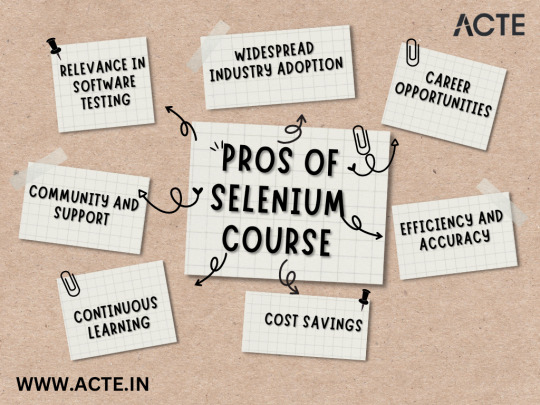
The Benefits of Our Selenium Course
Comprehensive Curriculum: Our course is designed to cover everything from the fundamentals of automated testing to advanced techniques in Selenium, ensuring learners receive a well-rounded education.
Hands-on Experience: Practical exercises and real-world examples are incorporated to provide learners with the opportunity to apply their knowledge in a realistic setting.
Expert Instruction: You’ll be guided by experienced instructors who have a profound understanding of Selenium and its application in the industry, ensuring you receive the best possible education.
Flexibility: Our course offers flexible learning options, allowing you to study at your own pace and convenience, ensuring a stress-free learning experience.
Industry Recognition: Completion of our Selenium course will provide you with a valuable certification recognized by employers worldwide, enhancing your career prospects within the IT industry.
Who Should Enroll?
Novice Testers: If you’re new to the world of automated testing and aspire to become proficient in Selenium, our course is designed specifically for you. We’ll lay a strong foundation and gradually guide you towards becoming a pro in Selenium automation.
Experienced Testers: Even if you already have experience in automated testing, our course will help you enhance your skills and keep up with the latest trends and best practices in Selenium.
IT Professionals: Individuals working in the IT industry, such as developers or quality assurance engineers, who want to broaden their skillset and optimize their testing processes, will greatly benefit from our Selenium course.
In conclusion, our Selenium course is a one-stop solution for individuals seeking to dominate automated testing and excel in their careers. With a comprehensive curriculum, hands-on experience, expert instruction, and industry recognition, you’ll be well-prepared to tackle any automated testing challenges that come your way. Make the smart choice and enroll in our Selenium course at ACTE Technologies today to unlock your full potential in the world of software testing.
7 notes
·
View notes
Video
youtube
Kanban, Waterfall, and DevOps are three different approaches to project management and software development. Here's an overview of each concept: 1. Kanban: Definition: Kanban is a visual management method for software development and knowledge work. It originated from manufacturing processes in Toyota and has been adapted for use in software development to improve efficiency and flow.
Key Concepts: Visualization: Work items are represented on a visual board, usually with columns such as "To Do," "In Progress," and "Done."
Work in Progress (WIP) Limits: Limits are set on the number of items allowed in each column to optimize flow and avoid bottlenecks.
Continuous Delivery: Focus on delivering work continuously without distinct iterations.
Advantages: Flexibility in responding to changing priorities.
Continuous delivery of value. Visual representation of work enhances transparency.
Use Case: Kanban is often suitable for teams with variable and unpredictable workloads, where tasks don't follow a fixed iteration cycle.
2. Waterfall: Definition: The Waterfall model is a traditional and sequential approach to software development. It follows a linear and rigid sequence of phases, with each phase building upon the outputs of the previous one.
Phases: Requirements: Define and document project requirements. Design: Create the system architecture and design. Implementation: Code the system based on the design. Testing: Conduct testing to identify and fix defects. Deployment: Deploy the completed system to users. Maintenance: Provide ongoing support and maintenance.
Advantages:
Clear structure and well-defined phases.
Documentation at each stage.
Predictable timelines and costs.
Disadvantages: Limited flexibility for changes after the project starts.
Late feedback on the final product.
Risk of customer dissatisfaction if initial requirements are misunderstood.
Use Case: Waterfall is suitable for projects with well-defined requirements and stable environments where changes are expected to be minimal.
3. DevOps: Definition: DevOps (Development and Operations) is a set of practices that aim to automate and improve the collaboration between software development and IT operations. The goal is to shorten the development lifecycle, deliver high-quality software, and foster a culture of continuous integration and delivery.
Key Practices: Continuous Integration (CI): Merge code changes frequently and automatically test them.
Continuous Delivery/Deployment (CD): Automate the release and deployment processes.
Collaboration: Promote collaboration and communication between development and operations teams.
Advantages: Faster delivery of software. Reduced manual errors through automation. Improved collaboration and communication.
Use Case: DevOps is suitable for organizations aiming to achieve faster and more reliable delivery of software through the automation of development, testing, and deployment processes.
#mktmarketing4you #distributionchannels #HoshinPlanning #Leanmethods #marketing #M4Y #lovemarketing #IPAM #ipammarketingschool #Kanban #ContingencyPlanning #virtual #volunteering #project #Management #Economy #ConsumptionBehavior #BrandManagement #ProductManagement #Logistics #Lifecycle #Brand #Neuromarketing #McKinseyMatrix #Breakevenanalysis #innovation #Facebook #icebergmodel #EdgarScheinsCultureModel #STARMethod #VRIO #7SFramework #gapanalysis #AIDAModel #SixLeadershipStyles #MintoPyramidPrinciple #StrategyDiamond #InternalRateofReturn #irr #BrandManagement #dripmodel #HoshinPlanning #XMatrix #backtobasics #BalancedScorecard #Product #ProductManagement #Logistics #Branding #freemium #businessmodel #business #4P #3C #BCG #SWOT #TOWS #EisenhowerMatrix #Study #marketingresearch #marketer #marketing manager #Painpoints #Pestel #ValueChain # VRIO #marketingmix We also left a video about Lean vs Agile vs Waterfall | What is Lean | Difference between Waterfall and Agile and that could help you. Later we will leave one about Kanban:
2 notes
·
View notes
Text
Brandon Belcher – CPA Marketing Academy: The Complete CPA Mastery Roadmap for 2025
Are you ready to turn simple traffic into commissions without selling a product or managing inventory? If yes, then Brandon Belcher – CPA Marketing Academy could be the breakthrough you've been searching for. This online course is designed to help beginners and intermediate marketers master Cost Per Action (CPA) marketing, one of the most powerful and scalable methods to earn passive income online.
CPA marketing allows you to earn money when someone takes a specific action—like filling out a form, entering an email, or downloading an app. Unlike affiliate marketing, you don't need your customer to make a purchase. That’s what makes it so beginner-friendly and scalable.
In this in-depth guide, we'll cover everything you need to know about the Brandon Belcher – CPA Marketing Academy Program, its modules, learning outcomes, and why it stands out in the digital marketing world. Let's dive in.
What is Brandon Belcher – CPA Marketing Academy?
The Brandon Belcher – CPA Marketing Academy Online Course is a high-value training designed to take you from a complete novice to a confident CPA marketer. The course walks you through the entire journey of setting up, managing, optimizing, and scaling CPA campaigns using free traffic, paid ads, and automated systems.
Brandon Belcher, the creator of the course, is a renowned digital entrepreneur known for his no-nonsense, results-driven approach. He has helped thousands of students across the world generate real income using digital strategies—especially through CPA marketing.
This course teaches the same CPA blueprint Brandon has used to earn six figures per month, and it's structured in a beginner-friendly yet comprehensive way. From understanding networks to setting up profitable campaigns, this program covers it all.
Who is Brandon Belcher?
Brandon Belcher is a seasoned online marketer with over a decade of experience in affiliate and CPA marketing. He is known for creating straightforward, actionable courses that produce results. His focus on simplicity and automation makes his training programs especially ideal for beginners.
Unlike many course creators who rely on outdated theory, Brandon practices what he preaches. He shares real case studies, ad strategies, traffic generation techniques, and conversion hacks inside the Brandon Belcher – CPA Marketing Academy Online Program, ensuring students stay ahead in the evolving digital space.
What’s Inside the Course?
Here’s what you can expect to learn in the CPA Marketing Academy Online Course By Brandon Belcher:
✅ Introduction to CPA Marketing
What CPA marketing is and how it works
How to choose the right CPA networks
Understanding different types of CPA offers (email submits, zip codes, downloads, etc.)
✅ Setting Up Your Foundation
Creating a strong online presence
Building landing pages that convert
Choosing the best tools and software (free and paid options)
✅ Free Traffic Mastery
How to generate leads without spending money on ads
Leveraging platforms like YouTube, TikTok, Quora, and Instagram for traffic
SEO basics to bring organic leads to your landing pages
✅ Paid Traffic Strategies
Facebook Ads and Google Ads for CPA
Understanding compliance and ad approval
How to test, optimize, and scale winning campaigns
✅ Automation & Scaling
How to use autoresponders, chatbots, and funnels for hands-off profits
Scaling your CPA campaigns to $1,000/day and beyond
Using analytics and tracking tools to improve ROI
✅ Bonus Resources
Real campaign walkthroughs
Swipe files and templates
Access to Brandon’s private student group for support and networking
Why Choose This Course?
The CPA Marketing Academy Online Program By Brandon Belcher stands out because it simplifies a complex model like CPA marketing and makes it achievable for complete beginners. Here’s what makes this course a must-have:
🎯 No Fluff, Just Action: Every module focuses on execution and results.
📈 Beginner to Advanced: Whether you're just starting or want to scale existing campaigns, there’s something for everyone.
💻 Free and Paid Strategies: Learn how to build success with or without a budget.
🧠 Lifetime Access & Updates: Stay updated with evolving methods and algorithm changes.
🧑🤝🧑 Support Community: Access Brandon's active group for mentorship, feedback, and live updates.
Whether you're a freelancer, student, or someone looking to build a side income, the course offers a roadmap that is sustainable and highly scalable.
Who Is This Course For?
This course is ideal for:
Beginners who want to start an online business with no product or inventory
Affiliate marketers looking to switch to CPA for faster conversions
Content creators who want to monetize their traffic
Agency owners or freelancers offering CPA setup as a service
Anyone looking for passive income streams through automation
If you fall into any of these categories, the Brandon Belcher – CPA Marketing Academy Program could be your launchpad to consistent online earnings.
Student Reviews & Testimonials
Here’s what learners are saying about the CPA Marketing Academy Online Course By Brandon Belcher:
“I launched my first campaign within a week of enrolling and started getting conversions on day two. Brandon’s style is super easy to follow.” — Rahul M., Digital Marketer
“I tried affiliate marketing before but failed. This course opened my eyes to CPA. I’m now making over $300 per day thanks to this system.” — Lisa R., Freelancer
“The bonus templates and ad strategies are GOLD. I’ve never seen so much value in a course under this price.” — David S., Side Hustler
Where to Buy the Course
Want to enroll in the Brandon Belcher – CPA Marketing Academy Online Program?
We strongly recommend purchasing it from the trusted platform: 👉 ECOMKEVIN COURSE
You’ll get immediate access, exclusive updates, and secure checkout. Whether you’re a beginner or someone looking to sharpen your skills in CPA marketing, this is the best investment you can make this year.
Final Thoughts
The Brandon Belcher – CPA Marketing Academy is more than just another marketing course. It’s a complete blueprint to help you start, grow, and scale a CPA business from scratch. With clear instructions, practical strategies, and access to tools and templates, you’re setting yourself up for consistent success.
So, if you’re ready to build real income through CPA marketing in 2025, there’s no better place to start than this course.
Get started today through ECOMKEVIN COURSE and take the first step toward financial freedom with CPA.
0 notes
Text
DevSecOps Certification: Everything You Need to Know
Introduction: Why DevSecOps Matters More Than Ever
In today’s world of frequent cyberattacks and rapidly evolving software deployment cycles, integrating security into every stage of the software development process is no longer optiona it's essential. That’s where DevSecOps comes in. Short for Development, Security, and Operations, DevSecOps is a modern approach that ensures security is baked into DevOps workflows right from the beginning.
Whether you’re a developer, operations engineer, or cybersecurity enthusiast, earning a DevSecOps Certification can significantly boost your career prospects. But with so many courses, pathways, and free training options available, how do you navigate your way through them?
In this blog, we’ll walk you through everything you need to know about DevSecOps certifications including the DevSecOps certification path, popular credentials, DevSecOps training free options, and how to get started with a DevSecOps course online.
What Is DevSecOps?
DevSecOps is the practice of integrating security into every phase of the software development lifecycle from initial design through integration, testing, deployment, and software delivery. The core idea is simple: build security into the product, not just add it on at the end.
Traditionally, security was handled after the development phase, but this created bottlenecks and vulnerabilities. DevSecOps solves this by automating security checks and fostering a culture of shared responsibility among developers, operations teams, and security professionals.
Why Get a DevSecOps Certification?
1. Career Growth and Demand
As cyber threats rise and organizations prioritize secure deployments, professionals with DevSecOps expertise are in high demand. Certified professionals are often considered for higher-paying roles, including:
DevSecOps Engineers
Application Security Engineers
Cloud Security Architects
Secure DevOps Consultants
According to industry studies, DevSecOps roles have seen a salary increase of 12–15% over the last three years.
2. Stand Out in the Job Market
With a DevSecOps certification, you demonstrate validated expertise. Whether you're applying for a new job or seeking promotion, a recognized credential makes your resume stand out.
3. Structured Learning Path
DevSecOps certifications follow a logical progression. You learn the principles of secure development, gain practical experience with tools, and build confidence through real-world use cases.
The DevSecOps Certification Path: Beginner to Advanced
To help you plan your journey, here’s a simplified DevSecOps certification path you can follow based on your experience level:
Step 1: DevSecOps Tutorial for Beginners
This is where you start if you’re new. A DevSecOps tutorial for beginners introduces:
Basic DevOps principles
Introduction to security automation
Security tools like SAST, DAST, and dependency scanning
Overview of CI/CD pipeline security
Free tutorials and videos are widely available and a great place to build your foundation.
Step 2: Enroll in a DevSecOps Course Online
After learning the basics, formalize your knowledge with a DevSecOps course online. This will help you:
Learn hands-on security practices
Master tools like Jenkins, GitLab, SonarQube, Aqua, and more
Secure container deployments using Kubernetes and Docker
Build secure CI/CD pipelines
Courses often include interactive labs, projects, and exams to test your understanding.
Step 3: Earn a Recognized DevSecOps Certification
Once you’re confident, pursue a certification that validates your skills. Some leading DevSecOps certifications include:
Certified DevSecOps Professional (CDP)
DevSecOps Foundation Certification
AWS DevSecOps Certification
Azure DevSecOps Certification
These certifications test your ability to integrate security in cloud-native environments and automate compliance processes.
Top DevSecOps Certifications You Should Know
Let’s break down some of the most recognized DevSecOps certifications in the industry today:
1. Certified DevSecOps Professional (CDP)
Focus: Tooling, automation, cloud security
Skills: CI/CD hardening, IaC security, secrets management
Format: Online exam with hands-on tasks
2. DevSecOps Foundation Certification
Focus: Culture and principles
Ideal for: Managers, project leads, new practitioners
Format: Theory-based exam
3. AWS DevSecOps Certification
Focus: Securing AWS pipelines and cloud deployments
Ideal for: Cloud engineers and architects
Tools: AWS CodePipeline, AWS Inspector, GuardDuty
4. Azure DevSecOps Certification
Focus: Microsoft cloud environments
Tools: Azure DevOps, Defender for Cloud, Policy-as-Code
These certifications align with the DevSecOps certification path and offer specializations based on your platform or role.
DevSecOps Training Free Resources: Learn Without Paying a Dime
If you're not ready to invest financially, several DevSecOps training free options can help you start learning:
Open-source labs and GitHub projects: Many DevSecOps projects are freely available for experimentation.
Free online courses: Some platforms offer introductory DevSecOps course online modules at no cost.
YouTube tutorials: Channels provide real-world walkthroughs, especially for beginners.
H2K Infosys offers structured training with periodic free workshops and career guidance.
Use these resources to gain confidence before enrolling in paid certification courses.
What You’ll Learn in a DevSecOps Course Online
A well-structured DevSecOps course online will walk you through both theory and practical skills. Here's what a typical course covers:
Security Principles in DevOps
Shift-left security
Zero trust and secure defaults
Threat modeling and risk assessment
Toolchain Integration
Jenkins, GitHub Actions, GitLab CI
Static and dynamic analysis tools
Software Composition Analysis (SCA)
Cloud & Container Security
Docker image scanning
Kubernetes policy enforcement
Infrastructure as Code (IaC) security (e.g., Terraform, Ansible)
Secure CI/CD Pipelines
Secrets management (Vault, AWS Secrets Manager)
Security gates in CI/CD flows
Runtime monitoring and alerting
Real-World Use Cases of DevSecOps
Here are a few ways companies use DevSecOps in practice:
Case Study 1: Healthcare App Development
A health tech company integrated automated compliance checks to meet HIPAA requirements. This reduced manual testing efforts by 40% and improved deployment security.
Case Study 2: E-commerce Platform
A leading e-commerce provider used DevSecOps pipelines to block vulnerable packages before they reached production, preventing multiple high-severity CVEs.
These examples highlight how real-world DevSecOps application improves both speed and safety.
Tools Commonly Used in DevSecOps
Here are some tools you’ll likely use on your DevSecOps journey: FunctionToolsCI/CDJenkins, GitLab CI, GitHub ActionsStatic Analysis (SAST)SonarQube, CodeQL, FortifyDynamic Analysis (DAST)OWASP ZAP, Burp SuiteSCAWhiteSource, Snyk, OWASP Dependency-CheckContainer SecurityAqua Security, Twistlock, TrivySecrets ManagementHashiCorp Vault, AWS Secrets Manager
Hands-on knowledge of these tools is essential for most DevSecOps certifications.
Beginner Tips: How to Start with DevSecOps
If you're just starting out, here’s a simple roadmap to follow:
Watch a DevSecOps tutorial for beginners (understand basic concepts).
Explore DevSecOps training free materials (learn fundamentals without commitment).
Choose a beginner-friendly DevSecOps course online (gain hands-on experience).
Practice with real projects (create your own CI/CD pipeline and add security tools).
Attempt certification exams to showcase your skills to employers.
DevSecOps vs Traditional Security: Key Differences
AspectTraditional SecurityDevSecOpsTiming of SecurityPost-developmentEarly and continuousResponsibilitySecurity team onlyShared by dev, ops, and securitySpeedSlower release cyclesAccelerated with built-in checksToolingManual and reactiveAutomated and proactive
DevSecOps doesn't just improve security it enables faster delivery, greater agility, and reduced costs over time.
Who Should Pursue a DevSecOps Certification?
You don’t need to be a cybersecurity expert to begin. Ideal candidates include:
DevOps Engineers looking to add security skills
Developers wanting to write secure code
Security Analysts aiming to shift left
System Admins managing CI/CD pipelines
IT professionals seeking cloud security roles
Whether you're an entry-level professional or a senior engineer, there's a DevSecOps course online or certification tailored to your needs.
Why Choose H2K Infosys for DevSecOps Training?
H2K Infosys offers industry-aligned training programs tailored to both beginners and professionals. Their DevSecOps course online includes:
Real-time project implementation
Lab exercises with major DevSecOps tools
Career support and mock interviews
While many platforms offer tutorials, H2K Infosys emphasizes mentorship, hands-on learning, and job placement support making it a smart choice for career advancement.
Final Thoughts: Certification Is Just the Beginning
Getting certified in DevSecOps is not just about passing an exam it's about adopting a mindset that values speed, security, and collaboration. With the right training, tools, and resources, you can become an integral part of the software security movement.
Key Takeaways
DevSecOps certification validates your skills in secure development and CI/CD practices.
Start with a DevSecOps tutorial for beginners, then move to a structured DevSecOps course online.
Explore DevSecOps training free resources before committing to paid programs.
Choose certifications aligned with your career goals and technical background.
Hands-on learning with real tools is essential for success.
Platforms like H2K Infosys provide structured guidance and job-focused training.
Ready to level up your security skills? Start your DevSecOps journey today and future-proof your career. Explore certification paths, gain hands-on experience, and make your mark in secure DevOps.
0 notes
Text
The Role of Test Automation in DevOps and Continuous Integration Pipelines
The DevOps Imperative: DevOps relies on continuous integration (CI) and continuous delivery (CD), necessitating rapid code merging and releases. Manual testing falters at this pace. Test automation offers rapid feedback and early bug detection, turning testing from a bottleneck into a catalyst for faster validation.
Why Automation is DevOps’ Engine Lubricant
Incorporating automated tests into CI/CD pipelines yields significant benefits:
1. Instant Feedback Loop: Automated tests run upon code commits (unit, integration, API), providing immediate pass/fail signals, and preventing "it worked on my machine!" surprises.
2. Enabling Continuous Deployment: Reliable automation serves as a quality gate, allowing code to auto-deploy if tests pass—necessitating high test reliability, a focus of rigorous software testing courses in Hyderabad.
3. Early & Frequent Bug Detection (Shift-Left): Bugs caught minutes after introduction are easier and cheaper to fix than those found later. Automation facilitates consistent shift-left testing.
4. Risk Mitigation for Frequent Changes: Automated regression tests create a safety net, ensuring new features don’t disrupt existing functionality with each release.
5. Resource Optimization: Frees QA engineers from repetitive tasks, allowing them to concentrate on complex test design and quality advocacy.
Case Study: The E-Commerce Giant Running on Automation
Consider a real-world DevOps leader:
A major e-commerce platform faces:
Challenge: Thousands of daily code commits; must handle Black Friday traffic; zero tolerance for checkout disruptions.
Automation in CI/CD:
1. On Commit: Developer pushes code → CI server triggers smoke & unit tests → Immediate feedback.
2. Nightly: Full regression suite runs, simulating holiday traffic.
3. Gatekeeper: If all tests pass → Code auto-deploys to production.
Outcome:
Rapid, reliable releases (multiple deploys/day).
Critical bugs caught before user impact.
Proven resilience during sales spikes.
Significant reduction in manual regression effort.
This illustrates how automation underpins high-speed, high-quality DevOps.
The Crucial Counterbalance: Why Manual Testing Isn't Dead
Automation is powerful but not foolproof. Over-reliance brings challenges:
Flaky Tests: Unreliable tests damage trust in the pipeline, leading to ignored failures. Maintenance is essential.
UX Blind Spot: Automation struggles with subjective assessments of UI intuitiveness and workflow satisfaction.
Complex Scenario Gaps: Automating intricate business logic or dynamic content can be overly complex or costly.
Exploration Deficit: Automated tests follow scripts and may miss unexpected bugs a human tester could discover through exploration.
The Winning Strategy: Hybrid Vigilance
Effective teams find balance:
1. Automate Relentlessly:
Repetitive Tasks: Logins, form fills, core workflows.
High-Risk Areas: Checkout and payments.
Performance & Load: Essential for scalability.
API Contracts: Reliable backend validation.
2. Empower Manual Testing:
Exploratory Testing: Human-driven investigations for UX and unexpected behavior.
Complex Business Logic: Scenarios requiring intricate rules or multiple dependencies.
Usability & Accessibility: Assessing design, flow, and compliance.
Verifying Bug Fixes: Ensuring fixes work and don't introduce new issues.
3. Leverage Automation for Manual Support: Use automation to prepare complex test scenarios, enhancing manual testing efficiency.
Understanding this balance is a key outcome of a comprehensive software testing course in Hyderabad.
Building a Robust Automation Pipeline: Key Considerations
Maximizing automation's impact requires strategy:
1. Toolchain Integration: Connect testing frameworks (Selenium, Cypress, etc.) with CI servers and deployment tools.
2. Fast & Reliable Tests: Prioritize speed. Slow tests disrupt the CI feedback loop. Ensure test reliability with thorough maintenance.
3. Test Pyramid Adherence:
Base: Widely employed, fast Unit Tests.
Middle: Limited Integration & API Tests.
Top: Few, carefully chosen UI End-to-End Tests.
(Avoid a heavy focus on slow, brittle UI tests!)
4. Shift-Left Culture: Developers and QA share responsibility for quality, integrating tests early.
5. Monitoring & Analytics: Track test performance metrics for visibility and improvement.
Mastering this framework is a core focus in a practical software testing course in Hyderabad.
Skills for the DevOps Automation Engineer
Success in this role requires a unique skill set:
Programming Proficiency: Java, Python, JavaScript/TypeScript, or C.
Test Automation Frameworks: Experience with Selenium, Cypress, REST Assured, etc.
CI/CD Mastery: Managing Jenkins, GitLab CI, to trigger tests effectively.
Version Control (Git): Essential for collaboration.
Cloud & Containerization Basics: Familiarity with AWS/Azure/GCP, Docker, Kubernetes.
API Testing: Validating microservices communication.
Performance Testing Concepts: Using tools like JMeter or K6.
Test Design & Maintenance: Creating robust and maintainable automation.
Collaboration & Communication: Bridging between Dev, Ops, and QA teams.
Acquiring this skill set is crucial, and a leading software testing course in Hyderabad offers the structured learning needed.
Conclusion: Speed with Confidence
Test automation is vital for achieving DevOps velocity and CI/CD success. It provides the rapid feedback and safety net necessary for frequent, confident releases. However, teams must understand that automation excels in speed and repetition, whereas human testers are invaluable for judgment and exploration.
By strategically automating suitable tests, integrating them effectively into the pipeline, diligently maintaining them, and empowering manual testers to focus on high-value areas, organizations can achieve the ultimate DevOps goal: delivering high-quality software at market speed. For professionals, mastering this domain opens up immense career opportunities. Ready to transform testing from a bottleneck to a turbocharger in your DevOps pipeline? How would you prioritize what to automate first in your current workflow? Equip yourself with essential skills—discover how a premier software testing course in Hyderabad can prepare you to design, build, and maintain the automated safety nets essential for modern software delivery!
1 note
·
View note
Text
Price: [price_with_discount] (as of [price_update_date] - Details) [ad_1] Leading with Quality is your essential guide to thriving as a modern software test leader in an era of continuous delivery, AI-powered development, and skyrocketing customer expectations.Written by Gopinath Kathiresan, a seasoned expert with over 15 years in software quality engineering, this practical playbook moves beyond traditional QA mindsets. Instead, it equips leaders with real-world strategies to drive impact across engineering, business, and product teams.Inside, you’ll discover:How to shift from reactive testing to proactive quality engineeringWays to build psychologically safe teams and instill a quality-first cultureTechniques for scaling automation, using meaningful metrics, and leading with dataInsights on embedding testing in DevOps, CI/CD pipelines, and cloud-native architecturesThe future of quality: AI, LLM-driven testing, and predictive defect detectionStructured into three actionable parts—Quality Leadership Foundations, Technical Excellence, and Influence & Innovation—this book delivers frameworks, case studies, and reflection exercises designed to make you not just a better tester, but a transformative leader.Whether you’re leading a small QE team or influencing global product quality at scale, this book will help you turn quality into your organization’s biggest competitive advantage. ASIN : B0F87YL57Q Language : English File size : 5.4 MB Simultaneous device usage : Unlimited Enhanced typesetting : Not Enabled X-Ray : Not Enabled Word Wise : Not Enabled Format : Print Replica [ad_2]
0 notes
Text
Marketing Automation Roadmap by VBF STUDIOS
Introduction
Marketing is not the one who used to be a decade ago. Consumers are clever and sharp and focus less. Where marketing is a step in automation. At VBF STUDIOS, we understand the power of automation and how to use it to build smart, scalable marketing strategies.
We proudly carry the badge of the best digital marketing agency in Noida, and one of the things that sets us apart is our foolproof Marketing Automation Roadmap.
What Is Marketing Automation?
Marketing uses software tools and platforms to automate repetitive marketing functions such as automation, email follow-up, lead nutrition, and social media posting – completing their team's time and maximising the results.
Why Marketing Automation Matters for Modern Businesses?
Let’s be real—manual marketing is old school. Automation helps businesses:
Deliver personalized experiences at scale
Nurture leads more effectively
Optimize marketing spend
And when done right, it becomes a silent revenue generator in the background.
About VBF STUDIOS
Who We Are
VBF STUDIOS is a full-stack digital marketing powerhouse based in Noida. We specialize in performance-driven campaigns, automation strategies, and next-gen customer experiences.
Why We’re Called the Best Digital Marketing Agency in Noida
Simple—we deliver. We blend creativity, data, and tech to build strong, automated marketing systems that bring measurable growth. And we’re not just saying that—our client results speak for themselves.
Understanding the Marketing Automation Roadmap
Here’s how we help businesses succeed with our 6-phase automation roadmap:
1 – Audit and Goal Setting
We start with a deep dive into your existing marketing. We analyze performance data, customer journeys, and bottlenecks. Then, we define crystal-clear automation goals aligned with your business objectives.
2 – Strategy and Tool Selection
You can’t just plug in any tool and expect magic. Based on your needs, we select the right tools—HubSpot, Mailchimp, Zoho, or custom CRM integrations. Then, we design your automation strategy for maximum impact.
3 – Content and Campaign Planning
Automation without content is like a car without fuel. We craft:
Email series
SMS flows
Retargeting ads
Funnel-specific landing pages
4 – Automation Setup
This is where tech meets strategy. We configure workflow, trigger, lead scoring and division. Everything works behind curtains like a well-oiled machine.
5 – Testing & Optimization
No strategy is right from the beginning. We run an A/B test, the user checks behaviour, fixes the drop-off, and fixes the entire automation system.
6 – Reporting & Scaling
We monitor KPI's open rates, clicks and conversions. Then we scale the work we are doing and fix what is not. Development never stops here.
Tools Used in Marketing Automation
CRM Integration
We use CRMs like HubSpot, Salesforce, or Zoho to track lead behavior and trigger workflows based on specific actions.
Email Marketing Automation
Email remains a core channel. Our automated drip campaigns boost engagement and sales with personalized timing and content.
Social Media Scheduling Tools
With tools like Buffer, Later, and Hootsuite, we schedule posts, track engagement, and automate social nurturing across platforms.
Benefits of Marketing Automation
Saves Time and Resources
Why waste time on manual tasks when automation can do the job 24/7?
Improves Conversion Rates
Leads get the right message at the right time, which naturally boosts conversion rates.
Enhances Customer Experience
From personalized welcome emails to abandoned cart reminders—your customers feel valued and understood.
Marketing Automation in Action – A VBF STUDIOS Case Study
A B2B SaaS company approached us with poor lead engagement. Within 60 days:
We implemented a lead nurturing funnel
Automated email sequences
Added behavioral tracking
Result: 3X increase in MQLs and a 40% boost in conversion rates
That’s the power of a proper roadmap.
Challenges in Marketing Automation (And How We Solve Them)
Automation can go wrong if:
The workflows are too complex
Messages feel robotic
Systems don’t integrate
Our approach avoids these pitfalls with clear strategy, humanized content, and technical precision.
Why Choose VBF STUDIOS for Your Marketing Automation Journey?
Because we don’t sell templates—we create custom blueprints tailored to your business goals. Our experts stay updated, our creatives stay sharp, and our results stay strong. That’s why we’re known as the best digital marketing agency in Noida.
#best digital marketing agency in noida#digital marketing#digital marketing agency#digital marketing service#seo
0 notes
Text
Top QA Challenges in 2025 You Can’t Ignore

Quality Assurance (QA) teams play a key role in delivering reliable software and products, but 2025 has brought its own set of challenges. In a fast-paced digital world driven by AI, automation, and growing user demands, QA teams are under pressure like never before. As someone with years of experience in the QA and tech industry, I’ve seen how these challenges evolve and how they’re affecting real teams today.
Let’s take a deep look at the top QA challenges in 2025 that every tech team should be aware of.
1. AI Testing Tools Are Evolving Faster Than Teams Can Adapt
AI-driven testing tools are becoming more common, but QA teams often struggle to keep up with how quickly these tools change. According to a 2024 Capgemini report, 73% of organizations are investing in AI-powered testing, but only 32% feel confident using them effectively.
This gap means that while companies are buying tools, their QA teams don’t always have the time or training to use them to their full potential. Learning curves, tool limitations, and integration issues are everyday problems. Platforms like Atlas help ease this transition by offering smart, easy-to-use insights that QA teams can act on without needing deep technical training making modern QA more manageable and efficient.
2. Test Automation Coverage Isn’t What It Should Be
Everyone talks about automation, but the reality is different on the ground. A SmartBear 2024 survey revealed that only 37% of testing is automated across organizations on average.
This leaves over 60% of QA work to manual testing, which increases time-to-market, creates human errors, and can overwhelm small QA teams. Automation requires a skilled team, time, and maintenance, resources many QA teams still lack in 2025.
3. More Devices, More Browsers, More Testing Complexity
With the rise of foldable devices, smart wearables, and more operating systems, QA teams are expected to test across an increasing number of platforms. Cross-browser and cross-device testing are no longer “nice to have”—they are essential.
In 2025, an average mobile app is expected to be tested on at least 25 different devices before launch, according to Applitools. QA teams are under pressure to simulate real-world conditions without having access to all these devices.
4. Security and Compliance Are Now QA Responsibilities
Security testing was once handled by specialized teams, but not anymore. With rising data privacy laws like the Digital Personal Data Protection Act (DPDP) in India and GDPR updates in the EU, QA teams are now expected to test not just for functionality, but also for compliance and security loopholes.
A Gartner study predicted that by 2025, 70% of QA teams will be involved in regulatory and security testing, a major shift from previous years. Many QA professionals are not trained in this area, leading to a skills gap that directly affects product release timelines.
5. Too Many Testing Tools, Not Enough Integration
Modern QA stacks are often cluttered with dozens of tools—Jira, Selenium, TestRail, Postman, Jenkins, and now AI-based test generators. While each tool serves a purpose, they don’t always work well together.
This leads to data silos, inconsistent reporting, and duplicated efforts. According to a TestGrid 2025 report, QA engineers spend nearly 20% of their time just managing test tools and environments, time that could be spent testing.
6. Remote QA Teams Face Communication Hurdles
Even in 2025, remote collaboration remains a challenge for QA teams. Test cycles require close coordination between developers, testers, and product teams. But when QA teams are distributed across time zones, issues like unclear test cases, delays in feedback, and overlooked bugs are common.
Despite using collaboration tools like Slack or Microsoft Teams, nearly 45% of QA leads say communication issues delay releases, according to Forrester’s State of DevOps 2024 report.
7. Burnout and Mental Fatigue Are Increasing
QA is often a thankless job. Testers work under tight deadlines, face constant pressure to “release fast,” and often get blamed when something breaks. In 2025, burnout among QA professionals is up by 30% compared to pre-pandemic levels, based on a TechWell survey.
This mental fatigue leads to lower test accuracy, higher turnover, and a drop in innovation. Organizations need to recognize this and invest more in mental health and support for their QA teams.
8. Flaky Tests Are Still a Major Problem
Flaky tests, that pass sometimes and fail at other times without code changes, continue to be a major productivity killer. In large test suites, even a 10% flakiness rate can waste hours of debugging time each sprint.
In fact, Google engineers have publicly shared that flaky tests can reduce developer productivity by 20–30%, and that’s in a company with highly advanced tooling. For smaller teams, this can completely derail testing cycles.
To stay ahead, QA leaders need tools that offer more than test coverage, they need real-time intelligence, regulatory insight, and historical patterns. That’s where Atlas Compliance tool is making a real impact. From understanding past FDA inspection trends to helping QA teams prepare for upcoming audits with confidence, Atlas is helping organizations shift from reactive to proactive.
In a year where a single oversight can cost millions, being prepared isn’t just smart—it’s essential.
1 note
·
View note
Text
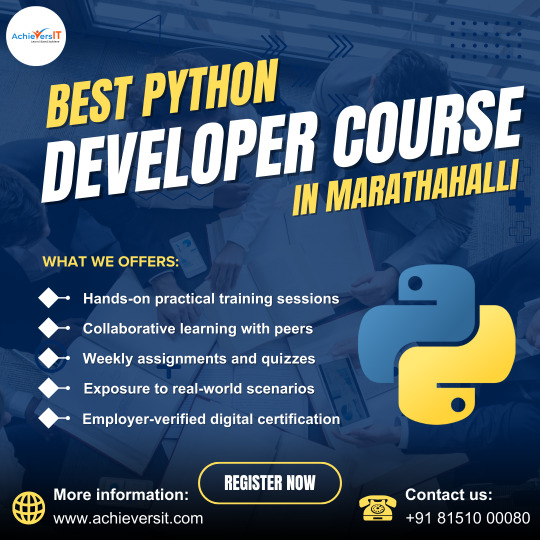
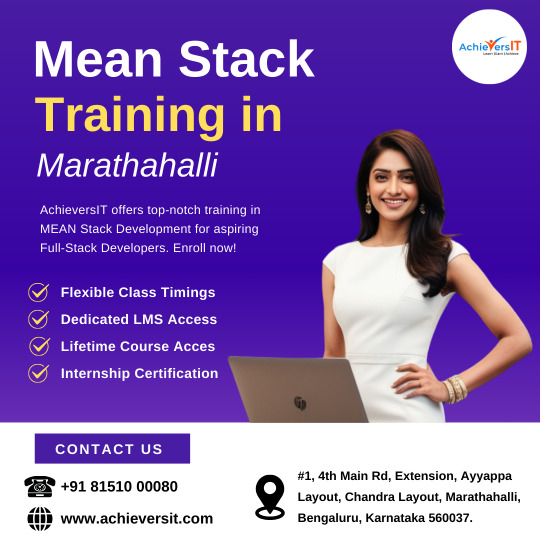
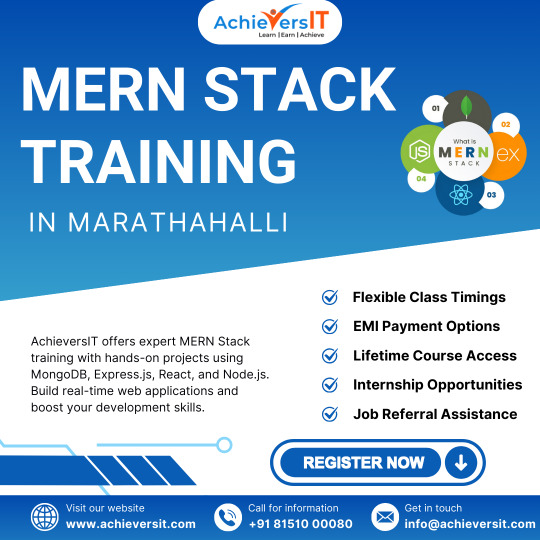


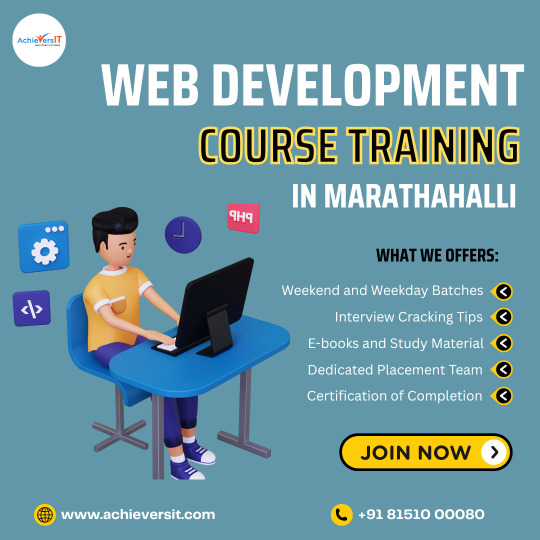


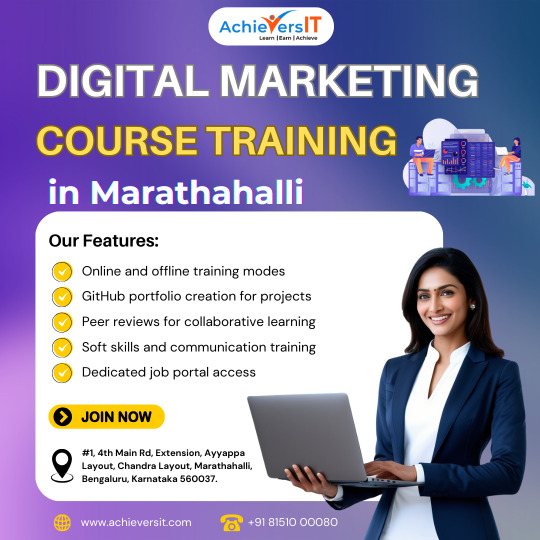

AchieversIT is a leading software training institute in Bangalore, known for delivering industry-relevant courses designed to boost your career. With expert trainers, hands-on projects, and real-time case studies, AchieversIT offers top-quality training in Full Stack Development, Data Science, Automation Testing, UI/UX, Digital Marketing, and more. Our certification programs, placement support, and personalized mentoring make us the go-to choice for aspiring IT professionals. Whether you're a fresher or looking to upskill, AchieversIT helps you build a strong foundation and succeed in the tech industry.
#Angular development training course in Bangalore#Reactjs development training course in Bangalore#MERN Stack training course in Bangalore#MEAN Stack training course in Bangalore#Python certification Course in Bangalore#UI Development Training institution in Bangalore
0 notes
Text
Unleashing the Power of Selenium: Advantages and the ACTE Technologies Advantage
In the dynamic landscape of software testing and quality assurance, studying Selenium offers a treasure trove of advantages. As an open-source automation tool tailored for web application testing, Selenium has swiftly gained recognition and prominence in the tech industry. This blog explores the manifold benefits of learning Selenium and shines a spotlight on ACTE Technologies, a reputable institution that plays a pivotal role in nurturing aspiring Selenium testers.

Advantages of Studying Selenium
Automation Efficiency: Selenium revolutionizes the testing process by automating repetitive and time-consuming tasks. Through the creation of test scripts, Selenium simulates user interactions with a web application, resulting in faster and more consistent testing. This not only enhances efficiency but also frees up testers for more creative and critical tasks.
Cross-Browser Compatibility: In today's diverse web environment, it's essential to ensure that web applications work seamlessly across various browsers. Selenium comes to the rescue with its support for multiple browsers, including Chrome, Firefox, Safari, and Internet Explorer. This comprehensive coverage minimizes the likelihood of browser-specific issues.
Language Flexibility: Selenium supports a range of programming languages, including Java, Python, C#, and more. This versatility empowers testers to choose a language they are comfortable with, making Selenium accessible to a wide spectrum of professionals. It opens doors to both newcomers and experienced developers, bridging the language divide.
Open Source: Selenium's open-source nature is a boon for organizations and individuals alike. It's freely available for use, significantly reducing costs. Furthermore, the active global community of Selenium developers ensures consistent updates and improvements, making it a valuable and evolving tool.
Robust Testing Frameworks: Selenium offers a variety of testing frameworks such as TestNG and JUnit. These frameworks streamline test case management, execution, and reporting. By providing a structured approach to testing, Selenium enables testers to work more efficiently and deliver high-quality results.
Integration Capabilities: Selenium can be seamlessly integrated with various third-party tools and frameworks. This includes Jenkins for continuous integration, TestRail for efficient test case management, and browser drivers for enhanced automation. These integrations enrich the Selenium ecosystem and enhance its capabilities.
Parallel Test Execution: Selenium facilitates parallel test execution, a feature that significantly reduces testing time. Multiple test scripts can run concurrently, resulting in quicker feedback on the application's quality. This feature is especially beneficial in today's fast-paced development environments.
Extensive Community Support: The Selenium community is not only extensive but also exceptionally active. This ensures that testers have access to a wealth of resources, including forums, documentation, tutorials, and Q&A platforms. When challenges arise, this community-driven support network is invaluable for troubleshooting and learning.
Real-Time Testing: Selenium enables real-time testing, allowing testers to observe test execution as it happens. This real-time monitoring is a vital tool for identifying and addressing issues promptly. Real-time insights ensure that testers can swiftly respond to any unexpected outcomes.
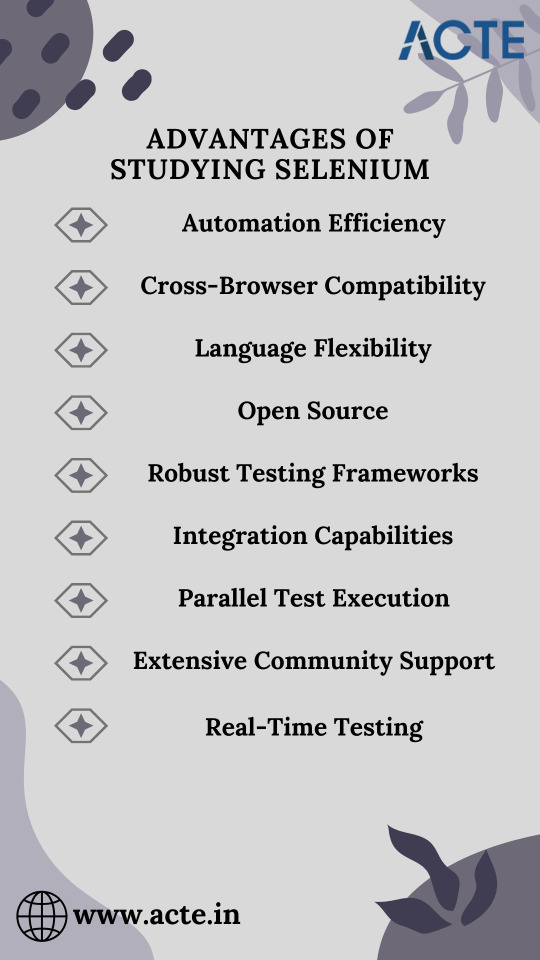
Conclusion:
Studying Selenium is a gateway to a world of opportunities and advantages. From automation efficiency to cross-browser compatibility and real-time testing, Selenium equips testers with the skills and tools needed to thrive in the ever-evolving field of software testing.
In this journey, ACTE Technologies emerges as a formidable institution that plays a vital role in nurturing aspiring Selenium testers. By offering a comprehensive curriculum, experienced instructors, hands-on learning, flexible learning options, and extensive career support, ACTE Technologies stands as a beacon for those looking to acquire the knowledge and skills needed to excel in this dynamic and in-demand field.
Whether you're a newcomer eager to embark on a career in Selenium testing or an experienced professional seeking to upskill, ACTE Technologies provides the resources and expertise to guide your path
4 notes
·
View notes
Text
How to Choose the Right Cloud App Development Company in India 2025
In today’s fast-paced digital world, choosing the right cloud app development company in India can make or break your business’s technological future. Whether you're a startup or an enterprise, cloud applications offer flexibility, scalability, and cost-effectiveness — but only when built by the right team. As we move into 2025, the stakes are higher than ever with emerging technologies like artificial intelligence (AI) further enhancing cloud ecosystems.
So, how do you make the right choice for your cloud-based software needs? Here's a practical, no-hype guide for business owners and decision-makers who want real results without wasting time or money.
Understand Your Business Goals
Before you even start looking for a development partner, get clear on what you need. Are you building a SaaS platform? Migrating from legacy infrastructure to the cloud? Integrating AI to automate business functions?
Knowing your goals will help you determine the scope, required technologies (like AWS, Microsoft Azure, or Google Cloud), and whether you need a company that also offers AI development services in India.
Look for Relevant Industry Experience
Not all companies are created equal. A provider with proven experience in your industry will understand your unique challenges and compliance requirements.
For example, Fenebris India specializes in cloud applications development services for sectors like finance, e-commerce, and healthcare, offering both front-end user experience design and secure backend infrastructure.
Evaluate Technical Capabilities
A trustworthy cloud app development company should offer:
Expertise in platforms like AWS, Azure, or Google Cloud.
Experience with microservices architecture and containerization (Docker, Kubernetes).
Integration capabilities with third-party APIs and internal systems.
Optional AI and machine learning integration.
If your project has AI-driven features, make sure they also offer AI development services in India, like this from Fenebris India, which includes predictive analytics, chatbots, and intelligent automation.
Check for Scalability & Post-Launch Support
What happens after your app is live? A long-term development partner should provide maintenance, cloud cost optimization, performance monitoring, and continuous updates.
Companies that ignore post-launch responsibilities are a red flag. Go for a provider that offers full-cycle development, including ongoing DevOps support.
Assess Their Communication Style
No matter how skilled a team is, poor communication can derail any project. Look for companies that:
Assign a dedicated project manager.
Maintain transparency through regular updates and feedback loops.
Are open to using collaboration tools like Slack, Jira, or Trello.
Read their case studies, testimonials, and online reviews. You can even ask for direct client references.
Confirm Data Security Practices
With cyber threats on the rise, your app must be protected from the start. Ensure your chosen development partner:
Follows global security standards (ISO, GDPR, SOC2).
Encrypts data both at rest and in transit.
Performs regular security audits and penetration tests.
Evaluate Cost vs. Value
Yes, budget matters. But don’t fall for the lowest bidder. Instead, evaluate what you're getting for the price — quality code, future-proof architecture, responsive support, and strategic input.
You’re investing in a long-term partnership, not just a one-time project. Consider companies that align value with cost, not those that cut corners.
Ask About Their Development Process
A structured development process is essential. Look for Agile or DevOps-driven companies that provide iterative releases, regular feedback cycles, and flexible scaling options.
If AI plays a role in your application, verify whether the team uses pre-trained models, builds custom ML algorithms, or integrates third-party AI APIs.
Include Legal and Compliance Reviews
Don’t overlook the legal stuff. Ensure that the company:
Signs NDAs and respects intellectual property.
Is familiar with compliance standards relevant to your business (HIPAA, PCI-DSS, etc.).
Clearly outlines service-level agreements (SLAs), timelines, and penalties in contracts.
FAQs: Cloud and AI Development Services in India
1. What are cloud application development services? Cloud application development services involve building apps that run on cloud platforms like AWS, Azure, or Google Cloud. These apps are scalable, cost-efficient, and accessible from anywhere.
2. How do I choose the best cloud app development company in India? Look for companies with domain expertise, proven portfolios, transparent communication, and post-launch support. Always evaluate their tech stack and security protocols.
3. What are the benefits of using cloud apps for my business? Cloud apps reduce infrastructure costs, improve collaboration, scale easily, and often include built-in data backup and recovery features.
4. How is AI integrated into cloud applications? AI can power features like predictive analytics, intelligent search, chatbots, fraud detection, and automation within cloud-based apps.
5. What’s the cost of developing a cloud-based app in India? Costs vary based on complexity, tech stack, and developer experience, typically ranging from ₹5 lakhs to ₹50 lakhs or more.
6. Are Indian cloud development companies reliable for overseas clients? Yes, India is a top outsourcing destination for cloud and AI development due to its technical talent, cost-effectiveness, and English proficiency.
7. What technologies are commonly used in cloud app development? Common tools include React, Node.js, Python, Java, Docker, Kubernetes, AWS Lambda, and AI libraries like TensorFlow and PyTorch.
8. Can AI development be added to existing cloud apps? Yes. AI features like recommendation engines or NLP can be integrated into existing apps using APIs or custom models.
#ai development company in india#ai development services india#cloud app development services in india#cloud app development company#cloud based software company
0 notes
Text
How A Time Card Calculator Can Simplify Your Payroll Process

Running payroll can feel like navigating a maze—lots of numbers, tight deadlines, and careful attention to detail. But with the right tools, you can transform that stress into smooth sailing. One of the most helpful aids is a Time Card Calculator, which offers automated tracking and error-free results—saving time, reducing mistakes, and boosting team morale.
1. Why Manual Timekeeping Falls Short
Manually tracking hours worked—whether through spreadsheets or handwritten timesheets—comes with challenges:
Data entry errors: Transposing digits or logging inconsistent times leads to payroll headaches.
Compliance risks: Miscalculating hours, especially overtime, may result in labor law violations.
Time drain: Reconciling all entries is time-consuming and distracts from higher-level HR tasks.
If you're still relying on manual methods, your payroll process is likely slower, more error-prone, and harder to review.
2. Automation to the Rescue
This is where digital tools make a game-changing impact.
Easy Hour Entry
An automatic calculator lets employees log their clock‑in and clock‑out times in a few clicks. No more guessing hours or deciphering messy handwriting. Everything is timestamped precisely.
Built‑In Overtime Rules
Need to handle extra pay? A reliable Overtime Calculator handles automatic computation of overtime rates, based on your company’s policies or legal requirements. Whether it’s 1.5× pay after eight hours or weekend premiums, the system does the math for you.
Instant Work-Day Calculations
With embedded logic to calculate work days, your system can deduct weekends, count paid leave, and reflect public holidays—all without manual input. This ensures accurate payroll-ready data at payroll close.
3. Big-Time Benefits for Small Businesses

Reduce Errors & Liability
Automation eliminates most manual math mistakes. That lowers the chance of overpayment and ensures fair compensation—building employee trust and reducing legal exposure.
Save Valuable Time
What used to take hours of consolidating and auditing can now be finished in minutes. Faster payroll means happier HR teams, better cash flow planning, and more time for strategic initiatives.
User-Friendly Reporting
Digital tools frequently include built-in reporting dashboards. You can quickly track productivity, staffing costs, overtime trends, and historical patterns—all with a few clicks.
4. What to Look for in a Time Tracking Solution
When choosing a solution, keep the following in mind:
Ease of use: Employees should log hours simply—through mobile, web, or even kiosk entry.
Payroll compatibility: Make sure data can export to your payroll provider or accounting software.
Accurate overtime logic: The tool should support your local labor regulations and custom rules.
Work-day configurations: The ability to adjust holiday calendars, shift patterns, and leave types is essential.
Security & auditability: The system should offer tamper-proof time logs.
5. Real-Life Impact: A Case Study
Consider “Sunny Café,” a small business with 15 employees working varied shifts, including morning baristas and evening cooks. They used to tally hours manually and add overtime by hand each week. Mistakes were frequent, and payroll took several hours to finalize.
They adopted a tool combining a Time Card Calculator and Overtime Calculator in one package. With shift start/end times recorded automatically, weeks of payroll closed in under an hour. Employee clock-outs triggered immediate overtime notifications. Management could log holiday schedules to calculate work days accurately—even during seasonal peaks.
Results? Dramatic:
Payroll processing time dropped by 70%
Overtime disputes dropped from three/month to zero
Manager confidence skyrocketed—and employees appreciated timely, accurate pay
6. Tips to Smooth Implementation

Pilot with one department: Test the system first with a small team to refine settings and policies.
Train staff early: Show them how to clock in/out correctly—overtraining is better than under-prepping.
Review policies regularly: Legislation, overtime rules, and holiday schedules evolve—check your settings quarterly.
Always back up: Maintain records and export logs regularly. These are useful for audits and future reference.
Recommended Tools & Resources (Updated)
EmpMonitor – Offers advanced employee monitoring, automatic time tracking, and productivity analytics. Great for remote or hybrid teams.
Clockify – Free and paid plans with time tracking, team dashboards, and integrations.
Toggl Track – Intuitive interface suitable for freelancers and small teams.
TSheets by QuickBooks – Powerful scheduling, mobile clock-in/out, and seamless QuickBooks integration.
You can also watch this video: How To Measure Productivity Of Employee According To The Days In A Week With EmpMonitor?
youtube
7. Final Takeaway
A digital Time Card Calculator and overtime solution transforms payroll from a cumbersome monthly chore into a streamlined, accurate, and transparent process.
Whether you're a small business owner or HR manager, implementing a calculator that both tracks hours and flags overtime simplifies operations, improves compliance, and enhances satisfaction for everyone.
Ready to free yourself from payroll stress? Try one of the top-rated time card and overtime tools—and experience the smoother side of payroll first-hand!
#EmployeeTimeCalculator#WorkforceManagement#TimeTrackingSoftware#PayrollAccuracy#DigitalTimeTracking#Youtube
0 notes
Text
Unlock Your Cloud Career Potential with AWS Cloud Classes in Pune

AWS Cloud Classes in Pune
As technology evolves, so does the demand for professionals who can manage and scale cloud infrastructure. Amazon Web Services (AWS) has emerged as the global leader in cloud computing, and employers are actively hiring AWS-certified talent.
The Shift to Cloud and Why AWS Leads the Way
AWS provides over 200 fully featured services, from computing power and storage to machine learning and analytics. Its dominance across industries means professionals with AWS skills enjoy higher demand and better salaries.
Key Benefits of Learning AWS:
Offers robust tools for monitoring
Versatile for various tech roles, including data, security, and software
Perfect entry point into DevOps, AI/ML, and IoT
Certifications are globally accepted and highly respected
Why Pune is the Right Place to Learn Cloud Computing
Pune’s IT ecosystem continues to grow, with leading MNCs, startups, and product-based companies setting up their base. This makes it an ideal location to kickstart a cloud career.
Top Reasons to Learn AWS in Pune:
Growing tech infrastructure and cloud adoption
High demand for AWS-certified professionals locally
Opportunities for internships and fresher roles
Networking with cloud experts and developer communities
Access to institutes like WebAsha Technologies with industry-backed training
About WebAsha Technologies
WebAsha Technologies is a trusted name in IT education, known for its hands-on approach to technical training. Our AWS Cloud Classes in Pune are not just about passing exams—they’re designed to help you solve real-world cloud challenges.
What You Can Expect From Us:
Personalized attention from certified AWS instructors
Fully equipped lab access for practical learning
Structured curriculum with mini-projects and real scenarios
Career counseling and resume review sessions
Certification prep with mock tests and case studies
Course Breakdown: What You'll Learn
We’ve designed our AWS course to balance theory with direct application. It suits both absolute beginners and tech professionals looking to upgrade.
Major Learning Areas:
Understanding Cloud Fundamentals and AWS Setup
Launching and Managing Elastic Compute Cloud (EC2)
Implementing IAM for security and access control
Using S3 for versioned and encrypted storage
Designing Virtual Private Clouds (VPC)
Database configuration with Amazon RDS & DynamoDB
Building Lambda functions and serverless apps
Implementing fault-tolerant architectures
Automation with AWS CLI and SDK
Logging, auditing, and troubleshooting in AWS
Who Should Attend This Program?
Whether you’re switching domains or stepping into tech for the first time, this program can support your goals.
BCA, BSc, B.Tech/M.Tech students exploring career options
Developers learning cloud-native application design
Network/System Administrators upgrading to cloud infrastructure
Start-up founders need scalable and secure cloud knowledge
IT professionals transitioning into DevOps or Site Reliability Engineering (SRE)
Certifications You’ll Be Prepared For
After completing AWS Cloud Classes in Pune, you’ll be ready to appear for these global certifications:
AWS Certified Cloud Practitioner
AWS Certified Solutions Architect – Associate
AWS Certified Developer – Associate
AWS Certified SysOps Administrator – Associate
Each of these enhances your credibility and boosts hiring potential across the globe.
Conclusion: Your Future in Cloud Starts Today
If you’re looking to build a cloud-centric career, the right time to act is now. AWS continues to grow in influence, and companies are actively seeking certified talent. The AWS Cloud Classes in Pune by WebAsha Technologies can be your launchpad into this exciting and future-proof field.
0 notes